The number of Metrorail customers riding their bike to the train station increased by 50% over the last 5 years, as Metro makes progress towards its 2020 goal to attract more bicyclists.
More cyclists are accessing Metrorail by bike than ever before. According to results from the 2012 Metrorail Passenger Survey, the number of riders bicycling to Metrorail in the morning rush hour increased from around 1,550 to over 2,380 per day between 2007 and 2012. Bike access to Metrorail now accounts for 1% of entries each morning, which moves us closer to our Board-adopted goal of over 2% (over 7,000 bicycles!) by 2020.

In this survey, riders who access rail by bicycle in the morning peak could be taking Capital Bikeshare to the station, riding and parking their own bike at the station, or bringing a folding bike on-board. The Passenger Survey is one way we measure bicycle access. We see a similar pattern in our annual count of bike racks at stations each spring (currently nearing completion for 2013, stay tuned).
The growth in bike access has happened at the same time as bicycling is increasing generally in the region, and as Metro has added more bike racks at stations to accommodate and encourage bicycling, including a secure Bike & Ride parking prototype facility at College Park station.
The seven projects in Metro 2025 will 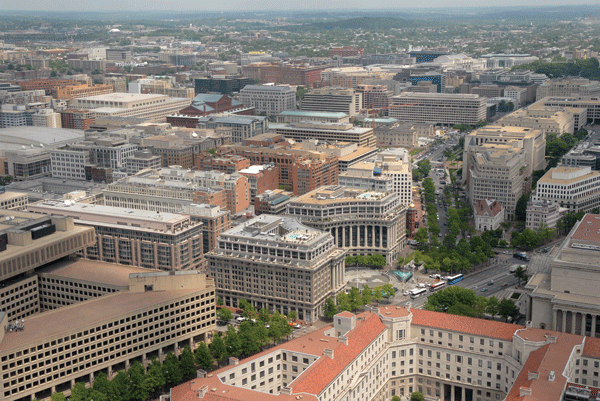 reduce road congestion, save money throughout the region, add riders to the Metro system, and make Metro rides more comfortable and efficient.
reduce road congestion, save money throughout the region, add riders to the Metro system, and make Metro rides more comfortable and efficient.
Capacity Increases to Support Additional Ridership
Metro 2025 investments will take 135,000 cars off the region’s roads, adding 300,000 boardings to transit, each day. This will help to reduce congestion while increasing transit ridership. With 100 percent eight-car trains, Metrorail will be able to carry the majority of those trips and have adequate capacity to carry the expected ridership of over one million daily trips by 2040. Implementing the full Priority Corridor bus network will enable increased bus use by over 100,000 daily trips by 2040. Next generation communications have helped draw new riders in Boston and Chicago. These investments save all travelers time and money, regardless of whether they ride.
We Lay the Groundwork for Expansion
Four of the Metro 2025 projects are prerequisites to outward expansion of Metrorail. Eighty percent of Metrorail riders travel to, or transfer at, one of a dozen core stations, but the core is reaching its capacity. Before expanding, the trains, tunnels, and stations downtown need to be able to handle the demand. Metro 2025 does this, and lays the groundwork for future rail transit expansion in the region.
Read more…
Walk access to Metrorail has increased 15% over the last 5 years, especially from those living within a half-mile of the station.
So more rail riders are choosing to walk to their Metrorail station, according to the 2012 Metrorail Passenger Survey. But who are these pedestrians?
Around 40% of Metrorail customers in the AM peak walk to the station. The survey found that younger people are much more likely to walk, with those under 35 were nearly twice as likely to walk to the train as those over 35:
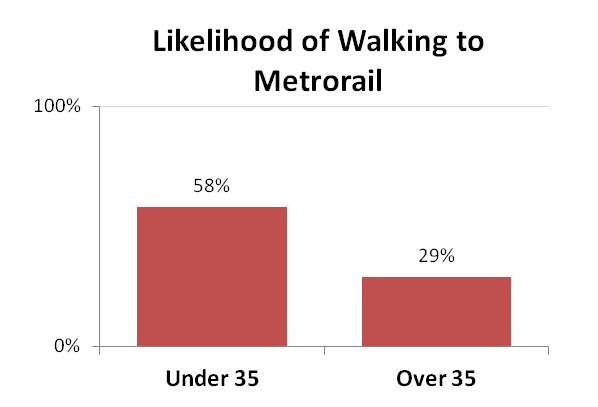 However, younger Metrorail riders are also more likely to live within walking distance of their Metrorail station. Half of all riders under 35 live within a half-mile Metrorail, while 22% of those over 35 do. Younger people in our region generally are slightly more likely to live near Metrorail – 15% of everyone under 35 in the region lives within a half-mile of Metrorail, 12% for those over 35. The chart below shows how younger riders tend to live closer to Metrorail: Read more…
However, younger Metrorail riders are also more likely to live within walking distance of their Metrorail station. Half of all riders under 35 live within a half-mile Metrorail, while 22% of those over 35 do. Younger people in our region generally are slightly more likely to live near Metrorail – 15% of everyone under 35 in the region lives within a half-mile of Metrorail, 12% for those over 35. The chart below shows how younger riders tend to live closer to Metrorail: Read more…
Walk access to Metrorail has increased 15% over the last 5 years, especially from those living within a half-mile of the station.
More and more Metrorail riders are lacing up their walking shoes and taking a short walk to their rail station these days. According to results from the 2012 Metrorail Passenger Survey, the number of passengers walking to Metrorail each morning grew by 15% between 2007 and 2012, from 78,500 to 89,900 in the AM peak period – far outpacing overall growth in ridership in the same period.
Where are all the new pedestrians coming from? From stations all over the network, but the growth is strongest among those walking a half-mile or less. Those walking from less than a half-mile rose by over 20% – faster than the overall growth in walk access.
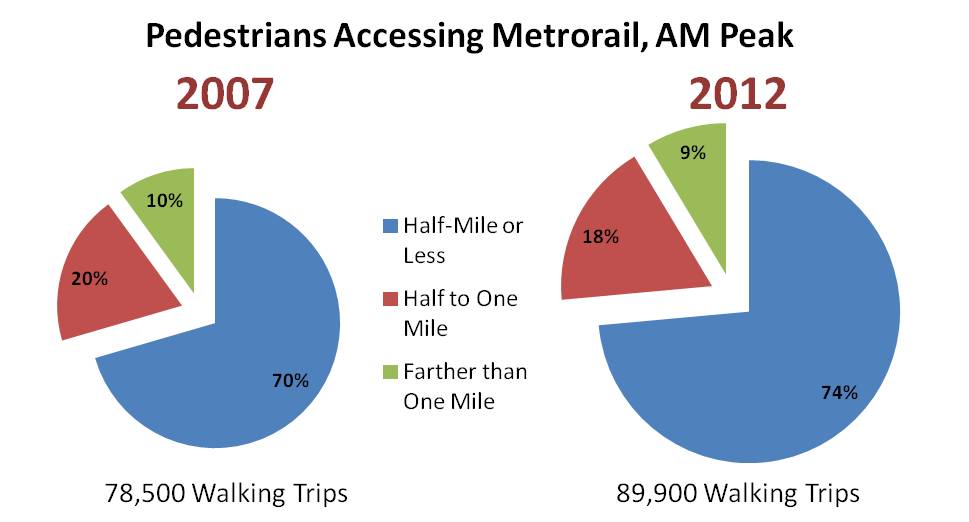
Walk access to Metrorail has increased 15% over the last 5 years, especially from those living within a half-mile of the station.
Read more…
Proximity to transit, especially high-quality, frequent, high-capacity rail, increases property values, attracts development and provides mobility choices. Property values are higher near Metro’s high-quality, high-frequency, high-capacity services, and deliver an incremental increase in total tax revenue to the Compact jurisdictions.
- Property taxes on land around Metrorail stations generate $3.1 billion annually in revenues to the jurisdictions.
- Of these revenues, $224 million is extra value that would not exist without Metro. This amount is equivalent to providing the following public services.
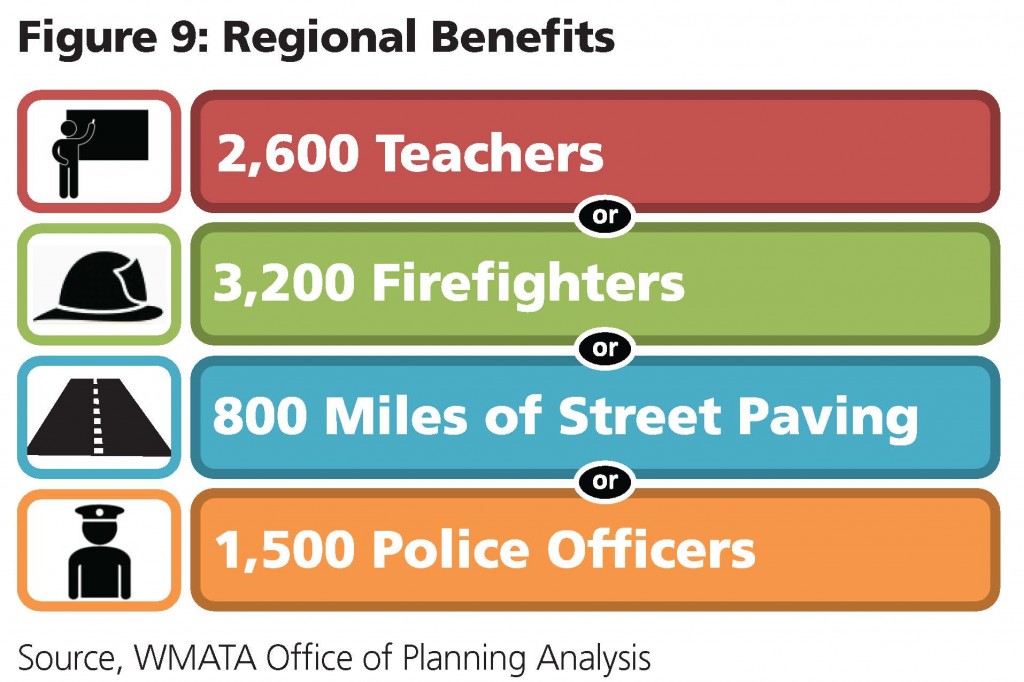
The strongest growth in ridership for Metrorail is coming from the inner jurisdictions of the District of Columbia, Arlington, and Alexandria. In these areas, home to 43% of all rail riders, ridership has grown twice as fast as the system as a whole.
Our 2012 Metrorail Passenger Survey can tell us where rail riders live, which is a key input for determining how Metro is funded by our regional partners. But it also gives us insight into where Metro’s growth markets are and how Metro’s ridership is evolving. Overall, rail ridership in the 2012 survey increased three percent since our prior passenger survey in 2007 – but where do our new riders live?

Where do Metrorail riders live? Ridership growth has been strongest among residents in inner jurisdictions, and has been holding steady in outer jurisdictions.
One-third of Metro parking customers drive from less than three miles to their station. But Metro’s importance can also be seen far across the greater Washington region, in this new visualization of parking customer’s origins.
Most Metrorail parking facilities primarily serve the neighborhoods immediately surrounding the station: 64%55% of parking customers come from less than five miles away, and 47%35% come from less than three miles away. However, some riders come from much farther away, particularly to end-of-line stations near major highways, such as Greenbelt, New Carrollton, and Vienna.
With approximately 60,000 parking spaces, Metro is one of the region’s largest parking operators. Our 2012 Metrorail Passenger Survey provides good insight into the travel patterns of rail customers, including those who drove and parked at any of Metro’s 35 stations offering daily parking. These parking customers represent around 15% of all rail trips on a typical weekday.
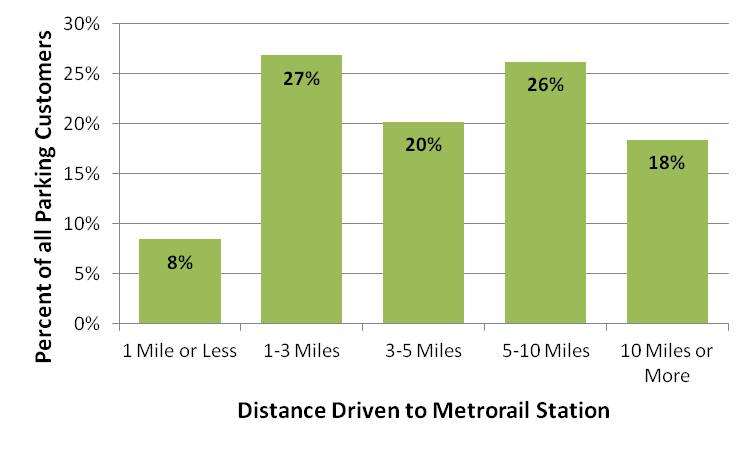
Read more…
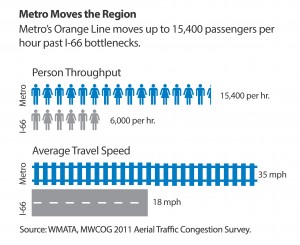
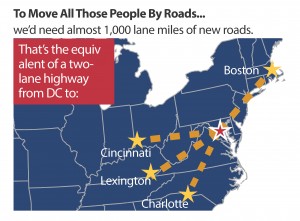
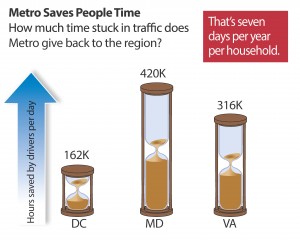 Metro does far more for the region than simply providing transportation. It also provides economic, social, and environmental benefits which contribute to the region’s health and vitality.
Metro does far more for the region than simply providing transportation. It also provides economic, social, and environmental benefits which contribute to the region’s health and vitality.
Making the Case for Transit (2011) found that without Metro and the regional transit system that it feeds:
- There would be one million more auto trips per day;
- Congestion would increase by 25 percent;
- All Potomac River crossings would need four to six additional lanes; and
- Downtown Washington would require 200,000 more parking spaces, which is the equivalent of 166 blocks of five-story garages, at a cost of at least $4 billion (2012), excluding land.
Read more…
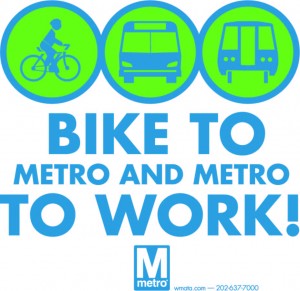
Join Metro at pitstops at Cheverly and West Hyattsville Metrorail stations on Bike to Work Day, May 17. Register now for your free T-shirt!
Bike to Work Day is coming soon – and biking to Metro counts too, especially for your free T-Shirt! If riding all the way to work sounds a little daunting, have no fear. Nearly every Metrorail station has bike racks where you can lock up your bike, and continue your commute by rail. And every Metrobus has a bike rack on the front with space for your bike, too.
So bike to Metro on Friday May 17 and pick up free stuff, too! There will be over 70 pitstops that morning, including many right near Metro stations.
This year, join Metro for Bike to Work Day pitstops at West Hyattsville and Cheverly stations for:
- Giveaways and maps
- Safety and transit tips
- Bus bike rack demonstration, with a bus on hand
Register now at biketoworkmetrodc.org, and enter pitstop West Hyattsville or Cheverly Metro stations.
West Hyattsville station is directly accessible to the Anacostia Northwest Branch trail and the Sligo Creek trail. Cheverly station has good bike access to the neighborhood of Cheverly to the north, and signs will guide bicyclists from Cheverly Ave. and Columbia Park Rd. We’ll have plenty of bike parking on hand for the day!
More about Bikes and Metro:
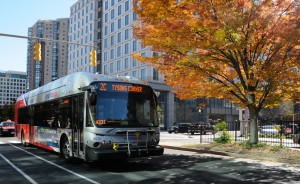
Some bus routes will change when the Silver Line arrives late this year.
When the Silver Line opens, many bus lines will be reorganized – to serve the five new Metrorail stations, change routes that will become redundant, and to ensure an integrated approach to the overall bus and rail network.
The Metro Board of Directors approved the Metrobus service changes in December (details). Exact schedules are not yet finalized but will become available as we get closer to the Silver Line opening at the end of the year.
60 bus routes serve the areas affected by the Silver Line, 13 of which are Metrobus routes. Metro has been working closely with Fairfax Connector, Loudoun County, and other operators to be sure all the changes work together and make sense. Generally, here’s what to expect:
- All 5 new Silver Line stations will have bus service
- Many Metrobus routes will be re-routed to serve the Tysons Corner area. Affected routes include the 1C, 2A, 2B, 2C, 2G, 2T, 3A-E, 3T, 15K, 15L, 15M, 23A, 23C, 24T, 28A, 28T, and 28X. (See the more detailed Metrobus proposal).
- A circulator bus system will serve the Tysons area, including the new Silver Line stations in Tysons
- Many Fairfax Connector buses connecting Reston and Herndon to West Falls Church station will now serve the Wiehle Avenue Silver Line station
- 7 Loudoun County buses will move from West Falls Church to Wiehle Avenue station
- 3 Prince William County buses will move to Tysons Corner station
- Going to Dulles Airport? Metrobus 5A will remain unchanged, and the express Washington Flyer buses will move from West Falls Church to Wiehle Avenue station.
When does all this happen? All bus changes will need to take effect by the first day of Silver Line operations!
For more information on Fairfax County bus changes in particular, visit their extensive website on the Silver Line changes.














Recent Comments